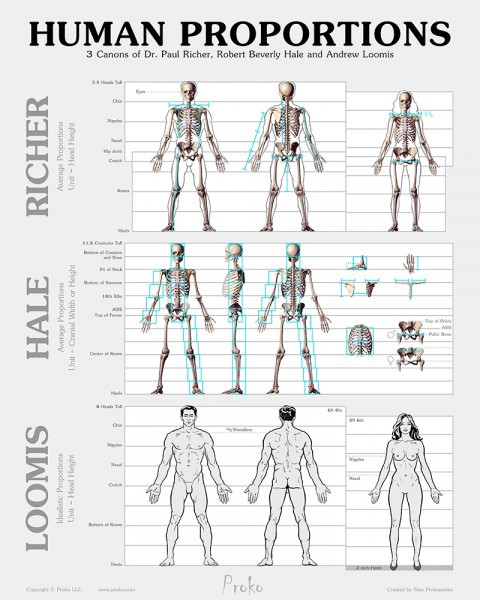Human Proportions – Idealistic Figures
$120
$150
You save $30
assignments 10 submissions
As I keep working on my figure drawing fundamentals, I spent today focusing on proportion measuring using the Loomis method as inspiration.
These are my study notes plus a quick sketch of my original character to test the method with a reference. It’s similar to Loomis, but I adjusted the measuring points a bit to fit my needs.
I basically cut the body in half, using the crotch as the midpoint. The upper half is divided into three sections:
1️⃣ Head
2️⃣ Shoulders
3️⃣ Elbows
The lower half is split into two sections:
1️⃣ Crotch to knees
2️⃣ Knees to feet
So in total, it’s three ‘boxes’ for the upper body and two for the lower body.
This might not be the “best” method for everyone, but it’s been helping me wrap my head around proportions—especially since I want my style to lean more toward anime than strict realism.
Just wanted to share my notes and example! :D
LESSON NOTES
![human figure proportions chart]()

This diagram is available for purchase as a Poster or a downloadable high resolution image in the premium section.
Throughout history artists have depicted the human form not as the average, but as the ideal. We find beauty and grace in length. So, in artwork, it’s more common for figures to be 8 or more heads tall rather than 7.5.
Loomis’s ideal proportions are very similar to Richer’s in the torso. One head down to the nipples, another to the navel, and another to the crotch. However Loomis makes the shoulders a bit wider at 2 ⅓ heads. He keeps the hips at 1.5 heads.
DOWNLOADS
human-proportions-loomis-premium-720p.mp4
15 MB
Proportions_Loomis_Premium_Transcript.txt
2 kB
Proportions-Diagram-300dpi.jpg
5 MB
ASSIGNMENTS
Study Loomis' Idealistic proportions
Study Loomis' Idealistic proportions. Copy them. Then, put the reference away and see if you can draw them from memory!
As I keep working on my figure drawing fundamentals, I spent today focusing on proportion measuring using the Loomis method as inspiration.
These are my study notes plus a quick sketch of my original character to test the method with a reference. It’s similar to Loomis, but I adjusted the measuring points a bit to fit my needs.
I basically cut the body in half, using the crotch as the midpoint. The upper half is divided into three sections:
1️⃣ Head
2️⃣ Shoulders
3️⃣ Elbows
The lower half is split into two sections:
1️⃣ Crotch to knees
2️⃣ Knees to feet
So in total, it’s three ‘boxes’ for the upper body and two for the lower body.
This might not be the “best” method for everyone, but it’s been helping me wrap my head around proportions—especially since I want my style to lean more toward anime than strict realism.
Just wanted to share my notes and example! :D
Don't think I'm having trouble memorizing the proportions just like the others struggling to get a clear diagram as well as some issues with symmetry.
Left is from reference and right from imagination. Even if I don't have the perfect anatomical details and general shapes memorized, rhythms have been helping me a lot when drawing them from imagination
The left is copy, and right is from memory. I like loomis method, it's easier for me in most situations.
The longer I study proportions, the more my brain wants to mess things up! On the right is a drawing from memory and it looks more heroic than the referenced midgets on the left. The female figure especially, since I tried drawing her without the heels. While I like the heroic proportions, I disliked Loomis's method the most. The upper limbs and hands are still the hardest to nail. I think that I will search for a method that mixes both Richer and Hale's logic.
Hey, I just wanted to say, that the female figure may look stumpier because you have drawn her 7 heads tall, when it should be 8 heads tall - just like with the male figure. The shorter average height comes from the smaller overall skull, as mentioned in the video.
Other then that they look quite nice! I think that you don't need to worry too much about sticking to one method and just use them for different occasions in the future.
i just want to applaud you for drawing a female figure without the heels - I always thought it is such bullshit to measure a it e with heels... I mean, I understand where it is coming from - commercial work - but also... Loomis, with all my love, wtf, man.
Last ones! First set is with reference, second set without.
I remembered the male chest proportions wrong on the front facing drawing and the figure looks a lot skinnier as a result. Also there's less detail and more anatomical inaccuracies in the second set but that was kinda expected given my lack of knowledge :)
Any feedback is appreciated as always!
Hi all, I finished some Loomis Proportion Studies;
The first three are using reference, the last 3 are recall.
Any feedback would be much appreciated, Thanks!
Test & Study of Loomis proportions. Prefer it over the richer method, but in general I concluded that Hale works the best for me.





